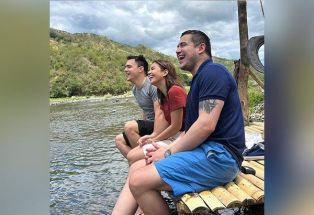Save our children from trauma
The recent torrential rains brought about by the habagat resulted in the expected heavy floods, affecting so many homes and lives.
It is not yet over. Our country averages about 17 to more than 20 typhoons each year. But have we learned our lessons from Ondoy, Pepeng and Sendong?
After the recent massive flooding came the rescue and relief operations.
Together with my husband, we participated in my daughter’s school’s relief efforts at the Libis covered court evacuation center, “home” to almost 200 families residing near the Marikina River displaced by the floods. They were also the same families affected by Ondoy.
Life being an evacuee is not new to them.
My seven-year-old daughter made and distributed sandwiches and hardboiled eggs, which she designed with “smiley” faces. I was touched to see the reaction of some kids upon seeing the eggs. One kid exclaimed, “Ay ang ganda naman ng itlog, may mukha!” as it instantly brought joy to his face. Such a small detail, but a child appreciated that “happy detail” amidst the hardships that he must be going through while staying in an evacuation center where life isn’t normal.
I looked straight into the eyes of the children, ages six to 10: Not a few of them seemed to stare aimlessly into space. You can almost read their minds: “Why am I here? Why is this happening to me? Will this ordeal ever stop?”
The younger ones, toddlers mostly, were busy playing, seemingly oblivious to the gravity of their ordeal. The infants were fast asleep, and thankfully, they were lying on clean beddings, which actually looked new. Thank heavens for the good Samaritans who donated the new beddings for the infants.
Given the cramped space in the covered court, kids still managed to play. Kids will always be kids. No matter the situation, they need to play, especially in times of stress.
There is more to relief operations than just dole-out, or the shotgun approach of giving a bagful of food, medicine and clothes to tide them over till the flood subsides.
Let us not forget the children who could be smiling and laughing on the outside but could be covering up something inside — their true feelings of being traumatized by the situation.
And their parents, who are too busy lining up for food, whose thoughts and energies are preoccupied with how to salvage their homes and things, may not be noticing what’s going on with their children’s feelings.
In my show Good Morning Club on TV5 last week, I interviewed Prof. Lourdes “Lulu” Medina. She is a Board Certified Expert in Traumatic Stress from The American Academy of Experts in Traumatic Stress (AAETS) New York. She is also an associate professor at the UST Graduate School and in the College of Education, where she handles Psychotrauma Management & Counseling courses. She is a trainer, facilitator and seasoned trauma therapist who has responded as lead debriefer to various disasters in the country — to name a few, the Somali hijacking/kidnapping, Glorietta Bombing, Luneta Bus Hijacking and Ondoy.
On the topic of children undergoing trauma brought about by natural calamities, disasters and man-made flooding, Prof. Medina shared the following:
The warning signs that children are traumatized:
Re-experiencing the trauma — Most common kids have this is through nightmares. They also repeat over and over parts of the event during play.
Avoidance/numbing — Kids avoid any reminders/triggers of the event. Some may have amnesia regarding the trauma (because it’s too painful to recall) while some become withdrawn and no longer participate in their usual activities.
Increased arousal — This means sleep difficulties, irritability and anger outbursts.
Other signs are: Hypervigilance, which is constantly searching their surroundings with signs of danger; and strong startle response, overreacting sometimes with panic to sounds and sudden movements.
Some common reactions are clinging, crying, not eating, whining, becoming more aggressive and difficulty concentrating on a task.
Most serious reaction is it developing into full-blown PTSD (Posttraumatic Stress Disorder).
What happens if left unnoticed or untreated?
Prof. Medina stated that, “If left untreated and for a prolonged period of time and much worse if repetitive in nature, the child’s psyche is distorted and damaged. This causes formation of negative self-beliefs (negative cognitions) such as ‘I am not good enough,’ ‘I am not worthy,’ ‘I am ugly,’ ‘I should have done something,’ etc. These negative self-beliefs are brought upon by the trauma frozen in time in the memory along with all the negatively-charged emotions. This cripples children, when they see themselves as unloved, useless and powerless. This becomes a learned helplessness.”
Oh my, poor children. I asked Prof. Medina, what can be done?
“It’s a partnership approach: Parents-Teachers-Community. Kids need these three S (Safety, Security and Support). Parents, Teachers, Community: It’s vital they get training on debriefing children so that in any event, kids shall be processed immediately; this way the trauma doesn’t get compounded/complicated which may result in psychological reactions such as anxiety, depression, psychosomatic reactions and PTSD.”
One immediate thing that can be done would be Trauma Release Exercise (TRE), which was originated by David Berceli, Ph.D.
TRE is simple and painless, designed to release the deep chronic muscle contractions created by severe shock or trauma. This is effective for ages seven years and up.
Exercise No. 1 (see illustration below):
Sit with your back against the wall as though there was a chair underneath you. This will put a stress on the quadriceps muscles. After a few minutes, you might begin to feel some quivering in these muscles. When this position becomes painful, move up the wall about two more inches. The quivering may get slightly stronger.
Again, if this becomes painful move your back up the wall for two more inches. You should try to find a position where your legs are quivering and there is no pain. After five minutes of quivering, stand up straight and hang over forward. Keep your knees slightly bent while you touch the ground. The quivering will most likely increase. Stay there for about three to four minutes. Once again close your knees very slightly, approximately another inch. The quivering may increase in its intensity. Allow this to happen.
This is one of the five TRE exercises, which aid in the rehabilitation of a child.
In my next column, I will share with you the other exercises that have been proven effective and helpful to children who are suffering from the trauma brought upon by natural calamities and disasters.
(To be concluded.)
- Latest
- Trending
























